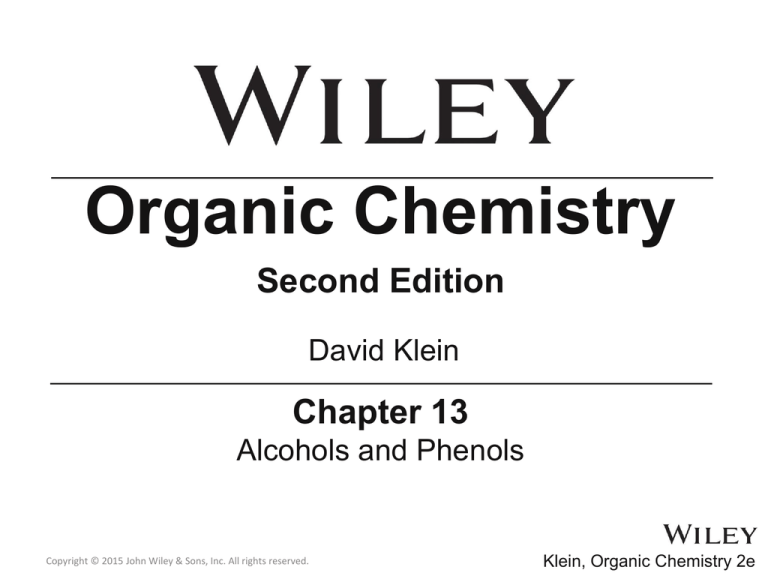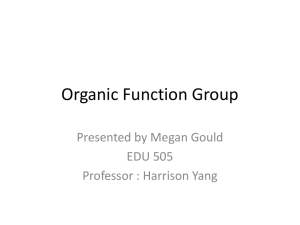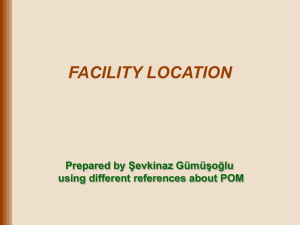
Organic Chemistry
Second Edition
David Klein
Chapter 13
Alcohols and Phenols
Copyright © 2015 John Wiley & Sons, Inc. All rights reserved.
Klein, Organic Chemistry 2e
13.1 Alcohols and Phenols
• Alcohols possess a hydroxyl group (-OH)
• Hydroxyl groups are extremely common in natural
compounds
Copyright © 2015 John Wiley & Sons, Inc. All rights reserved.
13-2
Klein, Organic Chemistry 2e
13.1 Alcohols and Phenols
• Hydroxyl groups in natural compounds
Copyright © 2015 John Wiley & Sons, Inc. All rights reserved.
13-3
Klein, Organic Chemistry 2e
13.1 Alcohols and Phenols
• Phenols possess a hydroxyl group directly attached to an
aromatic ring
Copyright © 2015 John Wiley & Sons, Inc. All rights reserved.
13-4
Klein, Organic Chemistry 2e
13.1 Alcohols Nomenclature
•
Alcohols are named using the same procedure we used
in Chapter 4 to name alkanes with minor modifications
1. Identify the parent chain, which should include the carbon
that the –OH is attached to
2. Identify and Name the substituents
3. Assign a locant (and prefix if necessary) to each substituent.
Give the carbon that the –OH is attached to the lowest
number possible
4. List the numbered substituents before the parent name in
alphabetical order. Ignore prefixes (except iso) when ordering
alphabetically
5. The –OH locant is placed either just before
the parent name or just before the -ol suffix
Copyright © 2015 John Wiley & Sons, Inc. All rights reserved.
13-5
Klein, Organic Chemistry 2e
13.1 Alcohols Nomenclature
•
Alcohols are named using the same procedure we used
in Chapter 4 to name alkanes with minor modifications
1. Identify the parent chain
Copyright © 2015 John Wiley & Sons, Inc. All rights reserved.
13-6
Klein, Organic Chemistry 2e
13.1 Alcohols Nomenclature
•
Alcohols are named using the same procedure we used
in Chapter 4 to name alkanes with minor modifications
3. Assign a locant (and prefix if necessary) to each substituent.
Give the carbon that the –OH is attached to the lowest
number possible taking precedence over C=C double bonds
Copyright © 2015 John Wiley & Sons, Inc. All rights reserved.
13-7
Klein, Organic Chemistry 2e
13.1 Alcohols Nomenclature
•
Alcohols are named using the same procedure we used
in Chapter 4 to name alkanes with minor modifications
5. The –OH locant is placed either just before the parent name
or just before the -ol suffix
•
R or S configurations should be shown at the beginning
of the name
Copyright © 2015 John Wiley & Sons, Inc. All rights reserved.
13-8
Klein, Organic Chemistry 2e
13.1 Alcohols Nomenclature
•
For cyclic alcohols, the –OH group should be on carbon
1, so often the locant is assumed and omitted
•
Common names for some alcohols are also frequently
used
Copyright © 2015 John Wiley & Sons, Inc. All rights reserved.
13-9
Klein, Organic Chemistry 2e
13.1 Alcohols Nomenclature
•
Like halides, alcohols are often classified by the type of
carbon they are attached to
•
WHY do we use these classifications?
Copyright © 2015 John Wiley & Sons, Inc. All rights reserved.
13-10
Klein, Organic Chemistry 2e
13.1 Alcohols Nomenclature
•
When an –OH group is attached to a benzene ring, the
parent name is phenol
•
Practice with SkillBuilder 13.1
Copyright © 2015 John Wiley & Sons, Inc. All rights reserved.
13-11
Klein, Organic Chemistry 2e
13.1 Alcohols Nomenclature
•
Name the following molecule
•
Draw the most stable chair conformation for (cis)-1isopropyl-1,2-cyclohexanediol
Copyright © 2015 John Wiley & Sons, Inc. All rights reserved.
13-12
Klein, Organic Chemistry 2e
13.1 Commercially Important Alcohols
•
•
•
Methanol (CH3OH) is the simplest alcohol
With a suitable catalyst, about 2 billion gallons of
methanol is made industrially from CO2 and H2 every
year
Methanol is poisonous, but it has many uses
1. Solvent
2. Precursor for chemical syntheses
3. Fuel
Copyright © 2015 John Wiley & Sons, Inc. All rights reserved.
13-13
Klein, Organic Chemistry 2e
13.1 Commercially Important Alcohols
•
•
•
Ethanol (CH3CH2OH) has been produced by
fermentation for thousands of years. HOW?
About 5 billion gallons of ethanol is made industrially
from the acid-catalyzed hydration of ethylene every
year
Ethanol has many uses
1. Solvent, precursor for chemical syntheses, fuel
2. Human consumption – ethanol suitable for drinking is heavily
taxed. Ethanol used for purposes other than drinking is often
denatured. WHY?
•
Is it poisonous?
Copyright © 2015 John Wiley & Sons, Inc. All rights reserved.
13-14
Klein, Organic Chemistry 2e
13.1 Commercially Important Alcohols
•
•
•
Isopropanol is rubbing alcohol. Draw its structure
Isopropanol is made industrially from the acid-catalyzed
hydration of propylene
Isopropanol is poisonous, but it has many uses
1. Industrial solvent
2. Antiseptic
3. Gasoline additive
Copyright © 2015 John Wiley & Sons, Inc. All rights reserved.
13-15
Klein, Organic Chemistry 2e
13.1 Physical Properties of Alcohols
•
•
The –OH of an alcohol can have a big effect on its
physical properties
Compare the boiling points below
•
Explain the differences
Copyright © 2015 John Wiley & Sons, Inc. All rights reserved.
13-16
Klein, Organic Chemistry 2e
13.1 Physical Properties of Alcohols
•
Because they can H-bond, hydroxyl groups can attract
water molecules strongly
•
Alcohols with small carbon chains are miscible in water
(they mix in any ratio). WHY?
•
Alcohols with large carbon chains do not readily mix
with water
Copyright © 2015 John Wiley & Sons, Inc. All rights reserved.
13-17
Klein, Organic Chemistry 2e
13.1 Physical Properties of Alcohols
•
Do hydrophobic groups repel or attract water?
•
WHY are molecules with large hydrophobic groups
generally insoluble in water?
Alcohols with 3 or less carbons are generally water
miscible
Alcohols with more than 3 carbons are not miscible,
and their solubility decreases as the size of the
hydrophobic group increases
•
•
Copyright © 2015 John Wiley & Sons, Inc. All rights reserved.
13-18
Klein, Organic Chemistry 2e
13.1 Physical Properties of Alcohols
•
An alcohol’s potency as an anti-bacterial agent depends
on the size of the hydrophobic group
•
To kill a bacterium,
the alcohol should
have some water
solubility. WHY?
To kill a bacterium,
the alcohol should
have a significant
hydrophobic region.
WHY?
•
Copyright © 2015 John Wiley & Sons, Inc. All rights reserved.
13-19
Klein, Organic Chemistry 2e
13.1 Physical Properties of Alcohols
•
Hexylresorcinol is used as an antibacterial and as an
antifungal agent
•
It has a good combination of hydrophobic and
hydrophilic regions
–
–
•
It has significant water solubility
Its nonpolar region helps it to pass through cell membranes
Practice with conceptual checkpoint 13.3
Copyright © 2015 John Wiley & Sons, Inc. All rights reserved.
13-20
Klein, Organic Chemistry 2e
13.2 Acidity of Alcohols and Phenols
•
A strong base is usually necessary to deprotonate an
alcohol
•
A preferred choice to create an alkoxide is to treat the
alcohol with Na, K, or Li metal. Show the mechanism for
such a reaction
•
Practice with conceptual checkpoint 13.4
Copyright © 2015 John Wiley & Sons, Inc. All rights reserved.
13-21
Klein, Organic Chemistry 2e
13.2 Acidity of Alcohols and Phenols
•
•
Recall from chapter 3 how ARIO is used to qualitatively
assess the strength of an acid
Lets apply these factors to alcohols and phenols
–
Atom
Copyright © 2015 John Wiley & Sons, Inc. All rights reserved.
13-22
Klein, Organic Chemistry 2e
13.2 Acidity of Alcohols and Phenols
•
Lets apply these factors to alcohols and phenols
–
Resonance
–
Explain why phenol is 100 million times more acidic than
cyclohexanol
Show all relevant resonance contributors
–
Copyright © 2015 John Wiley & Sons, Inc. All rights reserved.
13-23
Klein, Organic Chemistry 2e
13.2 Acidity of Alcohols and Phenols
•
Given the relatively low pKa of phenols, will NaOH be a
strong enough base to deprotonate a phenol?
Copyright © 2015 John Wiley & Sons, Inc. All rights reserved.
13-24
Klein, Organic Chemistry 2e
13.2 Acidity of Alcohols and Phenols
•
Lets apply these factors to alcohols and phenols
–
Induction: unless there is an electronegative group nearby,
induction won’t be very significant
–
Orbital: in what type of orbital do the alkoxide electrons
reside? How does that effect acidity?
Copyright © 2015 John Wiley & Sons, Inc. All rights reserved.
13-25
Klein, Organic Chemistry 2e
13.2 Acidity of Alcohols and Phenols
•
•
•
Solvation is also an important factor that affects acidity
Water is generally used as the solvent when measuring
pKa values
Which of the alcohols below is stronger?
•
ARIO cannot be used to explain the difference
Copyright © 2015 John Wiley & Sons, Inc. All rights reserved.
13-26
Klein, Organic Chemistry 2e
13.2 Acidity of Alcohols and Phenols
•
Solvation explains the difference in acidity
•
Draw partial charges on the solvent molecules to show
how solvation is a stabilizing effect
Practice with SkillBuilder 13.2
•
Copyright © 2015 John Wiley & Sons, Inc. All rights reserved.
13-27
Klein, Organic Chemistry 2e
13.2 Acidity of Alcohols and Phenols
•
Use ARIO and solvation to rank the following molecules
in order of increasing pKa
Copyright © 2015 John Wiley & Sons, Inc. All rights reserved.
13-28
Klein, Organic Chemistry 2e
13.3 Preparation of Alcohols
•
•
•
We saw in chapter 7 that substitution reactions can
yield an alcohol
What reagents did we use to accomplish this
transformation?
We saw that the substitution can occur by SN1 or SN2
Copyright © 2015 John Wiley & Sons, Inc. All rights reserved.
13-29
Klein, Organic Chemistry 2e
13.3 Preparation of Alcohols
•
•
The SN1 process generally uses a weak nucleophile
(H2O), which makes the process relatively slow
Why isn’t a stronger nucleophile (-OH) used under SN1
conditions?
Copyright © 2015 John Wiley & Sons, Inc. All rights reserved.
13-30
Klein, Organic Chemistry 2e
13.3 Preparation of Alcohols
•
In chapter 9, we learned how to make alcohols from
alkenes
•
Recall that acid-catalyzed hydration proceeds through a
carbocation intermediate that can possibly rearrange
How do you avoid rearrangements?
Practice with checkpoints 13.7 and 13.8
•
•
Copyright © 2015 John Wiley & Sons, Inc. All rights reserved.
13-31
Klein, Organic Chemistry 2e
13.4 Alcohol Prep via Reduction
•
•
•
•
A third method to prepare alcohols is by the reduction
of a carbonyl. What is a carbonyl?
Reductions involve a change in oxidation state
Oxidation state are a method of electron bookkeeping
Recall how we used formal charge as a method of
electron bookkeeping
–
–
Each atom is assigned half of the electrons it is sharing with
another atom
What is the formal charge on carbon in methanol?
Copyright © 2015 John Wiley & Sons, Inc. All rights reserved.
13-32
Klein, Organic Chemistry 2e
13.4 Alcohol Prep via Reduction
•
For oxidation states, we imagine the bonds breaking
heterolytically, and the electrons go to the more
electronegative atom
Copyright © 2015 John Wiley & Sons, Inc. All rights reserved.
13-33
Klein, Organic Chemistry 2e
13.4 Alcohol Prep via Reduction
•
•
•
•
•
Each of the carbons below have zero formal charge, but
they have different oxidation states
Calculate the oxidation number for each
Is the conversion from formic acid carbon dioxide an
oxidation or a reduction?
What about formaldehyde methanol?
Practice with SkillBuilder 13.3
Copyright © 2015 John Wiley & Sons, Inc. All rights reserved.
13-34
Klein, Organic Chemistry 2e
13.4 Alcohol Prep via Reduction
•
The reduction of a carbonyl requires a reducing agent
•
•
Is the reducing agent oxidized or reduced?
If you were to design a reducing agent, what element(s)
would be necessary?
Would an acid such as HCl be an appropriate reducing
agent? WHY or WHY NOT?
•
Copyright © 2015 John Wiley & Sons, Inc. All rights reserved.
13-35
Klein, Organic Chemistry 2e
13.4 Alcohol Prep via Reduction
•
There are three reducing agents you should know
1. We have already seen how catalyzed hydrogenation can
reduce alkenes. It can also work for carbonyls
–
Forceful conditions (high temperature and/or high pressure)
Copyright © 2015 John Wiley & Sons, Inc. All rights reserved.
13-36
Klein, Organic Chemistry 2e
13.4 Alcohol Prep via Reduction
•
Reagents that can donate a hydride are generally good
reducing agents
2. Sodium borohydride
Copyright © 2015 John Wiley & Sons, Inc. All rights reserved.
13-37
Klein, Organic Chemistry 2e
13.4 Alcohol Prep via Reduction
•
Reagents that can donate a hydride are generally good
reducing agents
3. Lithium aluminum hydride (LAH)
Copyright © 2015 John Wiley & Sons, Inc. All rights reserved.
13-38
Klein, Organic Chemistry 2e
13.4 Alcohol Prep via Reduction
•
•
Note that LAH is significantly more reactive that NaBH4
LAH reacts violently with water. WHY?
•
How can LAH be used with water if it reacts with water?
Copyright © 2015 John Wiley & Sons, Inc. All rights reserved.
13-39
Klein, Organic Chemistry 2e
13.4 Alcohol Prep via Reduction
•
Hydride delivery agents will somewhat selectively
reduce carbonyl compounds
Copyright © 2015 John Wiley & Sons, Inc. All rights reserved.
13-40
Klein, Organic Chemistry 2e
13.4 Alcohol Prep via Reduction
•
The reactivity of hydride delivery agents can be finetuned by using derivatives with varying R-groups
–
–
–
Alkoxides
Cyano
Sterically hindered groups
Copyright © 2015 John Wiley & Sons, Inc. All rights reserved.
13-41
Klein, Organic Chemistry 2e
13.4 Alcohol Prep via Reduction
•
LAH is strong enough to also reduce esters and
carboxylic acids, whereas NaBH4 is generally not
Copyright © 2015 John Wiley & Sons, Inc. All rights reserved.
13-42
Klein, Organic Chemistry 2e
13.4 Alcohol Prep via Reduction
•
To reduce an ester, 2 hydride equivalents are needed
Copyright © 2015 John Wiley & Sons, Inc. All rights reserved.
13-43
Klein, Organic Chemistry 2e
13.4 Alcohol Prep via Reduction
•
To reduce an ester, 2 hydride equivalents are needed
•
Which steps in the mechanism are reversible?
Copyright © 2015 John Wiley & Sons, Inc. All rights reserved.
13-44
Klein, Organic Chemistry 2e
13.4 Alcohol Prep via Reduction
•
Predict the products for the following processes
•
Practice with SkillBuilder 13.4
Copyright © 2015 John Wiley & Sons, Inc. All rights reserved.
13-45
Klein, Organic Chemistry 2e
13.5 Preparation of Diols
•
Diols are named using the same method as alcohols,
except the suffix, “diol” is used
Copyright © 2015 John Wiley & Sons, Inc. All rights reserved.
13-46
Klein, Organic Chemistry 2e
13.5 Preparation of Diols
•
If two carbonyl groups are present, and enough moles
of reducing agent are added, both can be reduced
Copyright © 2015 John Wiley & Sons, Inc. All rights reserved.
13-47
Klein, Organic Chemistry 2e
13.5 Preparation of Diols
•
Recall the methods we discussed in chapter 9 to
convert an alkene into a diol
Copyright © 2015 John Wiley & Sons, Inc. All rights reserved.
13-48
Klein, Organic Chemistry 2e
13.6 Grignard Reactions
•
•
•
Grignard reagents are often used in the synthesis of
alcohols
To form a Grignard, an alkyl halide is treated with Mg
metal
How does the oxidation state of the carbon change
upon forming the Grignard?
Copyright © 2015 John Wiley & Sons, Inc. All rights reserved.
13-49
Klein, Organic Chemistry 2e
13.6 Grignard Reactions
•
The electronegativity difference between C (2.5) and
Mg (1.3) is great enough that the bond has significant
ionic character
•
The carbon atom is not able to effectively stabilize the
negative charge it carries
Will it act as an acid, base, electrophile, nucleophile,
etc.?
•
Copyright © 2015 John Wiley & Sons, Inc. All rights reserved.
13-50
Klein, Organic Chemistry 2e
13.6 Grignard Reactions
•
If the Grignard reagent reacts with a carbonyl
compound, an alcohol can result
•
Note the similarities between the Grignard and LAH
mechanisms
Copyright © 2015 John Wiley & Sons, Inc. All rights reserved.
13-51
Klein, Organic Chemistry 2e
13.6 Grignard Reactions
•
Because the Grignard is both a strong base and a strong
nucleophile, care must be taken to protect it from
exposure to water
•
If water can’t be used as the solvent, what solvent is
appropriate?
What techniques are used to keep atmospheric
moisture out of the reaction?
•
Copyright © 2015 John Wiley & Sons, Inc. All rights reserved.
13-52
Klein, Organic Chemistry 2e
13.6 Grignard Reactions
•
Grignard examples
•
With an ester substrate, excess Grignard reagent is
required. WHY? Propose a mechanism
List some functional groups that are NOT compatible
with the Grignard
Practice with SkillBuilder 13.5
•
•
Copyright © 2015 John Wiley & Sons, Inc. All rights reserved.
13-53
Klein, Organic Chemistry 2e
13.6 Grignard Reactions
•
Design a synthesis for the following molecules starting
from an alkyl halide and a carbonyl, each having 5
carbons or less
Copyright © 2015 John Wiley & Sons, Inc. All rights reserved.
13-54
Klein, Organic Chemistry 2e
13.7 Protection of Alcohols
•
Consider the reaction below. WHY won’t it work?
•
The alcohol can act as an acid, especially in the
presence of reactive reagents like the Grignard reagent
The alcohol can be protected to prevent it from reacting
•
Copyright © 2015 John Wiley & Sons, Inc. All rights reserved.
13-55
Klein, Organic Chemistry 2e
13.7 Protection of Alcohols
•
A three-step process is required to achieve the desired
overall synthesis
Copyright © 2015 John Wiley & Sons, Inc. All rights reserved.
13-56
Klein, Organic Chemistry 2e
13.7 Protection of Alcohols
•
One such protecting group is trimethylsilyl (TMS)
•
The TMS protection step requires the presence of a
base. Propose a mechanism
Copyright © 2015 John Wiley & Sons, Inc. All rights reserved.
13-57
Klein, Organic Chemistry 2e
13.7 Protection of Alcohols
•
•
Evidence suggests that substitution at the Si atom
occurs by an SN2 mechanism
Because Si is much larger than C, it is more open to
backside attack
Copyright © 2015 John Wiley & Sons, Inc. All rights reserved.
13-58
Klein, Organic Chemistry 2e
13.7 Protection of Alcohols
•
•
The TMS group can later be removed with H3O+ or FTBAF is often used to supply fluoride ions
Copyright © 2015 John Wiley & Sons, Inc. All rights reserved.
13-59
Klein, Organic Chemistry 2e
13.7 Protection of Alcohols
•
Practice with conceptual checkpoint 13.18
Copyright © 2015 John Wiley & Sons, Inc. All rights reserved.
13-60
Klein, Organic Chemistry 2e
13.8 Preparation of Phenols
•
2 million tons of phenol is produced industrially yearly
•
•
Acetone is a useful byproduct
Phenol is a precursor in many chemical syntheses
–
–
–
–
Pharmaceuticals
Polymers
Adhesives
Food preservatives, etc.
Copyright © 2015 John Wiley & Sons, Inc. All rights reserved.
13-61
Klein, Organic Chemistry 2e
13.9 Reactions of Alcohols
•
Recall this SN1 reaction from section 7.5
•
For primary alcohols, the reaction occurs by an SN2
Copyright © 2015 John Wiley & Sons, Inc. All rights reserved.
13-62
Klein, Organic Chemistry 2e
13.9 Reactions of Alcohols
•
The SN2 reaction also occurs with ZnCl2 as the reagent
•
Recall from section 7.8 that the –OH group can be
converted into a better leaving groups such as a tosyl
group
Copyright © 2015 John Wiley & Sons, Inc. All rights reserved.
13-63
Klein, Organic Chemistry 2e
13.9 Reactions of Alcohols
•
SOCl2 can also be used to convert an alcohol to an alkyl
chloride
Copyright © 2015 John Wiley & Sons, Inc. All rights reserved.
13-64
Klein, Organic Chemistry 2e
13.9 Reactions of Alcohols
•
PBr3 can also be used to convert an alcohol to an alkyl
bromide
•
Note that the last step of the SOCl2 and PBr3
mechanisms are SN2
Practice with SkillBuilder 13.6
•
Copyright © 2015 John Wiley & Sons, Inc. All rights reserved.
13-65
Klein, Organic Chemistry 2e
13.9 Reactions of Alcohols
•
Fill in the necessary reagents for the conversions below
Copyright © 2015 John Wiley & Sons, Inc. All rights reserved.
13-66
Klein, Organic Chemistry 2e
13.9 E1 and E2 Reactions of Alcohols
•
In section 8.9, we saw that an acid (with a nonnucleophilic conjugate base) can promote E1
•
•
Why is E2 unlikely?
Recall that the reaction generally produces the more
substituted alkene product
Copyright © 2015 John Wiley & Sons, Inc. All rights reserved.
13-67
Klein, Organic Chemistry 2e
13.9 E1 and E2 Reactions of Alcohols
•
If the alcohol is converted into a better leaving group,
then a strong base can be used to promote E2
•
•
E2 reactions do not involve rearrangements. WHY?
When applicable, E2 reactions also produce the more
substituted product
Practice with conceptual checkpoint 13.21
•
Copyright © 2015 John Wiley & Sons, Inc. All rights reserved.
13-68
Klein, Organic Chemistry 2e
13.10 Oxidation of Alcohols
•
•
We saw how alcohols can be formed by the reduction
of a carbonyl
The reverse process is also possible with the right
reagents
Copyright © 2015 John Wiley & Sons, Inc. All rights reserved.
13-69
Klein, Organic Chemistry 2e
13.10 Oxidation of Alcohols
•
Oxidation of primary alcohols proceed to an aldehyde
and subsequently to the carboxylic acid
–
•
Very few oxidizing reagents will stop at the aldehyde
Oxidation of secondary alcohols produces a ketone
–
Very few agents are capable of oxidizing the ketone
Copyright © 2015 John Wiley & Sons, Inc. All rights reserved.
13-70
Klein, Organic Chemistry 2e
13.10 Oxidation of Alcohols
•
Tertiary alcohols generally do not undergo oxidation.
WHY?
•
There are two main methods to produce the most
common oxidizing agent, chromic acid
Copyright © 2015 John Wiley & Sons, Inc. All rights reserved.
13-71
Klein, Organic Chemistry 2e
13.10 Oxidation of Alcohols
•
When chromic acid reacts with an alcohol, there are
two main steps
Copyright © 2015 John Wiley & Sons, Inc. All rights reserved.
13-72
Klein, Organic Chemistry 2e
13.10 Oxidation of Alcohols
•
Chromic acid will generally oxidize a primary alcohol to
a carboxylic acid
•
PCC (pyridinium chlorochromate) can be used to stop
at the aldehyde
Copyright © 2015 John Wiley & Sons, Inc. All rights reserved.
13-73
Klein, Organic Chemistry 2e
13.10 Oxidation of Alcohols
•
PCC (pyridinium
chlorochromate) is
generally used with
methylene chloride as
the solvent
•
Both oxidizing agents
will work with
secondary alcohols
•
Practice with SkillBuilder 13.7
Copyright © 2015 John Wiley & Sons, Inc. All rights reserved.
13-74
Klein, Organic Chemistry 2e
13.10 Oxidation of Alcohols
•
Predict the product for the following reaction
Copyright © 2015 John Wiley & Sons, Inc. All rights reserved.
13-75
Klein, Organic Chemistry 2e
13.11 Biological Redox Reactions
•
•
•
Nature employs reducing and oxidizing agents
They are generally complex and selective. WHY?
NADH is one such reducing agent
Copyright © 2015 John Wiley & Sons, Inc. All rights reserved.
13-76
Klein, Organic Chemistry 2e
13.11 Biological Redox Reactions
•
The reactive site of NADH acts as a hydride delivery
agent
•
This is one way nature
converts carbonyls into
alcohols
Why is an enzyme required?
•
Copyright © 2015 John Wiley & Sons, Inc. All rights reserved.
13-77
Klein, Organic Chemistry 2e
13.11 Biological Redox Reactions
•
NAD+ can undergo the reverse process
•
The NADH / NAD+
interconversion plays a
big role in metabolism
Copyright © 2015 John Wiley & Sons, Inc. All rights reserved.
13-78
Klein, Organic Chemistry 2e
13.12 Oxidation of Phenol
•
•
•
Recall that tertiary alcohols do not undergo oxidation,
because they lack an alpha proton
You might expect phenol to be similarly unreactive
Yet, phenol is even more readily oxidized than primary
or secondary alcohols
Copyright © 2015 John Wiley & Sons, Inc. All rights reserved.
13-79
Klein, Organic Chemistry 2e
13.12 Oxidation of Phenol
•
Phenol oxidizes to form benzoquinone, which in turn
can be reduced to hydroquinone
•
•
Quinones are found everywhere in nature
They are ubiquitous
Copyright © 2015 John Wiley & Sons, Inc. All rights reserved.
13-80
Klein, Organic Chemistry 2e
13.12 Oxidation of Phenol
•
Ubiquinones act to catalyze the conversion of oxygen
into water, a key step in cellular respiration
•
Where in a cell do you think unbiquinones are most
likely found?
Copyright © 2015 John Wiley & Sons, Inc. All rights reserved.
13-81
Klein, Organic Chemistry 2e
13.12 Oxidation of Phenol
•
Ubiquinone catalysis:
Copyright © 2015 John Wiley & Sons, Inc. All rights reserved.
13-82
Klein, Organic Chemistry 2e
13.13 Synthetic Strategies
•
Recall some functional group conversions we learned
Copyright © 2015 John Wiley & Sons, Inc. All rights reserved.
13-83
Klein, Organic Chemistry 2e
13.13 Synthetic Strategies
•
Classify the functional groups based on oxidation state
Copyright © 2015 John Wiley & Sons, Inc. All rights reserved.
13-84
Klein, Organic Chemistry 2e
13.13 Synthetic Strategies
Copyright © 2015 John Wiley & Sons, Inc. All rights reserved.
13-85
Klein, Organic Chemistry 2e
13.13 Synthetic Strategies
•
Give necessary reagents for the following conversions
•
Practice with SkillBuilder 13.8
Copyright © 2015 John Wiley & Sons, Inc. All rights reserved.
13-86
Klein, Organic Chemistry 2e
13.13 Synthetic Strategies
•
Recall the C-C bond forming reactions we learned
Copyright © 2015 John Wiley & Sons, Inc. All rights reserved.
13-87
Klein, Organic Chemistry 2e
13.13 Synthetic Strategies
•
What if you want to convert an aldehyde into a ketone?
•
What reagents are needed for the following
conversion?
•
Practice with conceptual checkpoint 13.27 and
SkillBuilder 13.9
Copyright © 2015 John Wiley & Sons, Inc. All rights reserved.
13-88
Klein, Organic Chemistry 2e
Additional Practice Problems
•
Name the following molecule
•
Draw (1R,2R)-1-(3,3-dimethylbutyl)-3,5-cyclohexadien1,2-diol
Copyright © 2015 John Wiley & Sons, Inc. All rights reserved.
13-89
Klein, Organic Chemistry 2e
Additional Practice Problems
•
Use ARIO and solvation to rank the following molecules
in order of increasing pKa
Copyright © 2015 John Wiley & Sons, Inc. All rights reserved.
13-90
Klein, Organic Chemistry 2e
Additional Practice Problems
•
Predict the products for the following processes
Copyright © 2015 John Wiley & Sons, Inc. All rights reserved.
13-91
Klein, Organic Chemistry 2e
Additional Practice Problems
•
Design a synthesis for the following molecule starting
from an alkyl halide and a carbonyl, each having 5
carbons or less
Copyright © 2015 John Wiley & Sons, Inc. All rights reserved.
13-92
Klein, Organic Chemistry 2e
Additional Practice Problems
•
Give necessary reagents for the multi-step synthesis
below
Copyright © 2015 John Wiley & Sons, Inc. All rights reserved.
13-93
Klein, Organic Chemistry 2e








